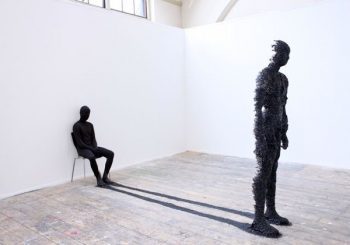Guest Writer for Wake Up World
In Part 1 of practicing shadow work we went over what the Shadow is and laid some foundation with common defense mechanisms that keep us from connecting with our shadow.
We know the Shadow is a composite character of everything that’s excluded from our waking consciousness, but why does the Shadow exist in the first place and where did it come from?
In order to better understand what the Shadow is, we need context and its context has to do with our journey from pure source consciousness into the realm of dense physicality, so saddle your broomstick ‘cause we’re going meta for this one.
Understanding Dimensions and Densities
Think of pure source consciousness as total unity with all that is; where there is no separation, nor differentiation between anything. All is one, thus, there is no “I” or separate self, there is only a self-generating energy field known as consciousness which all of creation sources from. This energy field both radiates outward and permeates through all layers of itself, animating the field of consciousness and exploring its varied expressions.
At that level of reality, there is no space or time, thus all is nonlocal and the center of the field is everywhere. It’s only when we enter the structure of Spacetime that there are concepts of relativity in order to navigate our relationship to everything else such as near and far, up and down, big and small, joy and grief, and so forth.
This is where dimensions and densities enter the scene.
A density is a specific bandwidth of frequency also known as a phase of consciousness.
The “further away” from the state of pure source consciousness, the slower, more dense the bandwidth of frequency will manifest.
The difference between density and dimension can be visualized as an elevator at the top floor of a translucent building. The vertical drop down each level would be the descending in density. Each floor of the building is a different level, or density, of consciousness with its own unique learning and curriculum to fulfill.
Each level is also superimposed over one another so that they all occupy the same space; and all the rooms on each floor of the building would be the dimensions i.e. parallel realities, timelines, versions of reality that operate under different laws, and alternate universes.
However calling a level of consciousness a dimension is not inaccurate either, since dimensions can refer to many things including a specific bandwidth of frequency or phase of consciousness.
If all else fails think of densities as a perpetual coming of age movie, and dimensions as anything—literally anything.
How the Shadow Arises
So what does this all have to do with the Shadow?
The Shadow is a result of our fragmentation from “dropping” in density to our home here in the third dimension.
In my article “Transcending the Victim/Perpetrator cycle,” I started it off by saying “The fragmented nature of this reality means that we experience and learn through contrast and polarity. Every light casts darkness in form of a shadow.”
That was a rather brief way of summing this up, yet still very true.
For us to be in such a solid, separate and concrete experience of reality that we are in, the vibratory rate from pure consciousness to this third dimensional phase of consciousness has to lower exceptionally. Everything has become a pixelated Rubik’s cube by the time we have a name and a body.
It is the much slower vibratory rate of this dimension that allows it to fragment and disperse so thoroughly into physicality, but with that fragmentation also comes division, duality, and polarization. With the ability to experience physicality, equally comes the division of our psyche into the conscious, subconscious, and unconscious.
The Shadow is an inherent part of this third dimensional experience.
It’s native to this phase of consciousness and to the many lessons we are here to learn. That’s not to say that all other phases of consciousness are without shadow or unblemished, but it does mean that with the amount of obscurity from our origins as pure source consciousness, the conditions of this dimension are generally harsh and prone to suffering.
We are not wrong for having a shadow, nor are we bad for having areas of our psyche left out of the light of our awareness.
Being fully healed would be to fully integrate our shadow and would shift us to a different phase of consciousness. We would no longer even be in this density, like changing the dial head of a radio to a different channel that accesses a different bandwidth of frequency.
Safe to say, if we have a body, we are on a healing journey whether we know it or not.
On the flip side of this, dropping in density allows for a vast array of adventures and experiences that cannot be accessed at other phases of consciousness. This means that the perception of matter and duality isn’t so black or white (pun intended). Our own freewill can determine whether we view our place in the multiverse as advantageous or forsaken.
Now that we have covered why the Shadow exists, our shadow work practice for part two is more focused than in part one. After exploring blocks to shadow work, we can examine the one thing that keeps us cycling in our personal dramas and dilemmas other than unconsciousness: addiction.
The Shadow and Addiction
Just how the Shadow is created through a dropping in density, addiction is inherently created by cycling through what remains unconscious inside our shadow.
Thoughts become addicting, behaviors become addicting, ways we perceive ourselves become addicting, storylines, conflict, stagnation, inertia, and feelings become addicting.
Discovering where we are hooked without even knowing it and what keeps us hooked, may not be a straightforward process, but by establishing the intent to understand these matters we already signal our subconscious to start retrieving this information. That is the beautiful thing about shadow work: when we approach it with openness and self-compassion, our consciousness creates a feedback loop where it works with us to set the healing process in motion.
Addiction can show up as many things that we wouldn’t normally place in that category.
Are we unknowingly addicted to situations where we have to prove our worth?
What keeps us stuck in toxic relationships? What experiences have we had that feel unresolved? What themes or perspectives are seeking completion? Are we unknowingly addicted to being around other people?
Are we addicted to feeling bad? Are we addicted to feeling good?
I have found within myself and in my clients, there is a strong emotional aspect that always needs addressing when healing addiction. It’s almost like addiction is there in place of something and once we make that “something” conscious, we begin to fill those spaces with our own self-love and presence. No doubt that this is easier said than done, but to even be willing to do this kind of healing is a sign that we are fully capable of it.
Shadow work is like coming out of an existential amnesia. When we start breaking cycles and uncovering hidden aspects that are ready to be integrated, it wakes us up into new versions of ourselves and opens doors to new possibilities.
Further reading from Sarah Elkhaldy:
- Two of Everything: Navigating Duality
- Blocks to Practicing Shadow Work
- Waking Up From Awakening
- Transcending The Victim/Perpetrator Cycle
- Knowledge Is Power – The Benefits of Conscious Awareness
- Thought Parasites – Our Ancient Mirrors
- Just Claim It All!
About the author:
 Sarah Elkhaldy is an energy healer trained in shamanic and holistic healing modalities that address soul loss, trauma, supporting the body in detoxification of chronic stressors and regeneration.
Sarah Elkhaldy is an energy healer trained in shamanic and holistic healing modalities that address soul loss, trauma, supporting the body in detoxification of chronic stressors and regeneration.
She is the administrator of the social media account: The Alchemist, where she shares esoteric knowledge to help humanity gracefully tap into our evolutionary potential. She considers it her work to connect the higher with the lower; the outer world with the inner world.
Sarah hosts retreats and workshops in Los Angeles on Alchemy and Shadow Work.
You can get in touch with Sarah here:
- Frequency Healing Sessions Email: [email protected]
- Instagram: instagram.com/the.alchemist/?hl=en
- Facebook: Sarah Elkhaldy
- Blog: alchemicalenergyhealing.com/thealchemist

If you've found value in our articles, we invite you to support the release of our brand-new book, "Gratitude Practices for Kids: A Practical Guide for Adults to Instill a Spirit of Appreciation and Positivity in the Next Generation."
"Gratitude Practices for Kids" brings together over 25 innovative and accessible practices designed to enhance gratitude in everyday life. This comprehensive guide is backed by 17 scientific studies, ensuring each concept is grounded in research, underscoring our commitment to nurturing growth, emotional intelligence, and positive interactions between adults and children.
We encourage you to opt for the paperback version to celebrate this new release. Dive into its fresh pages away from digital distractions, allowing you to immerse yourself in the transformative practices it offers.
Over recent years, Wake Up World has faced significant online censorship, which has impacted our financial ability to operate. Moving into book publishing represents a strategic step to secure the ongoing funds needed to continue our mission. By purchasing Gratitude for Kids, you help us keep our content free and accessible to everyone, avoiding needing a paywall. With over 8,500 articles published in the last 13 years, we remain dedicated to keeping our valuable content open to all.








